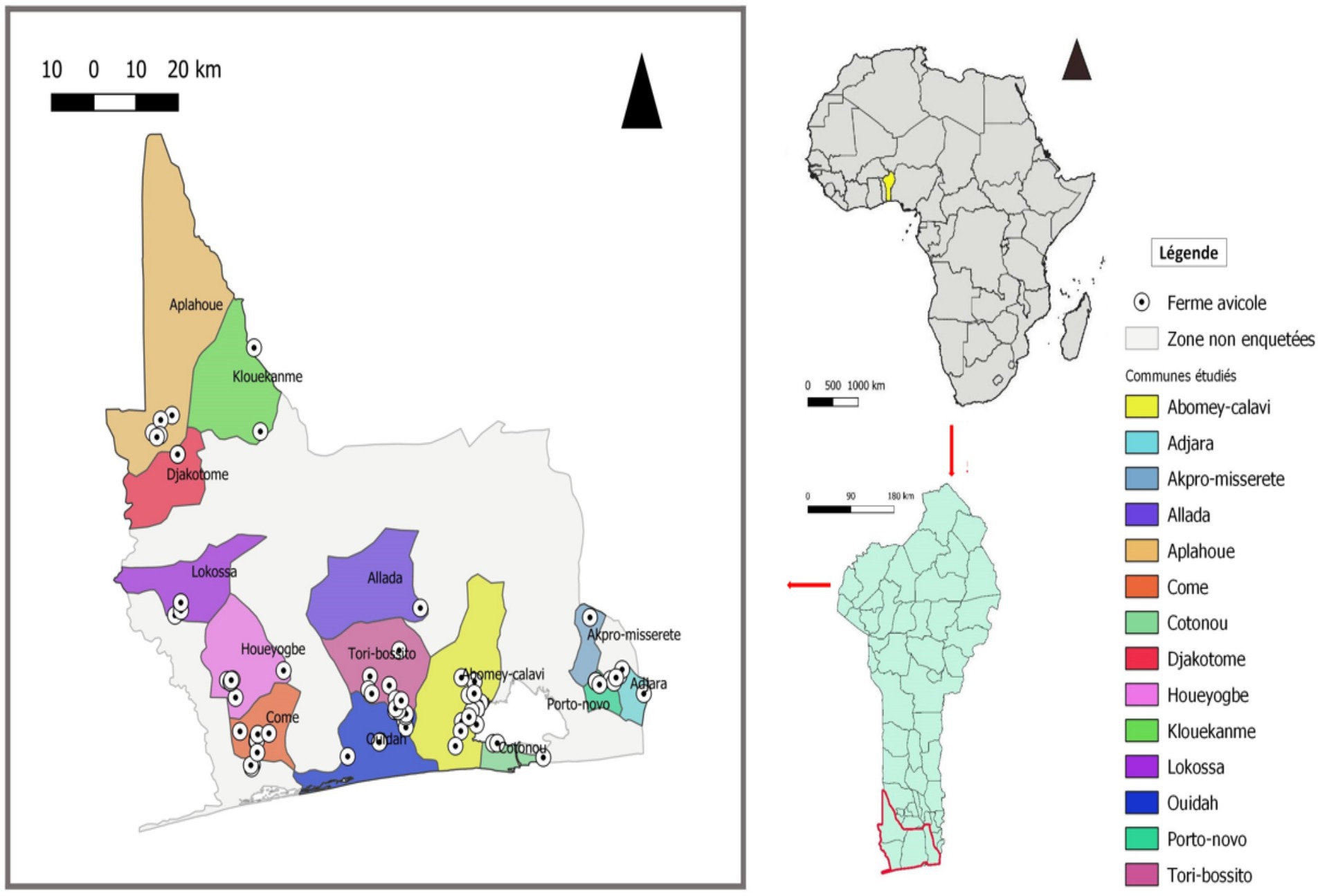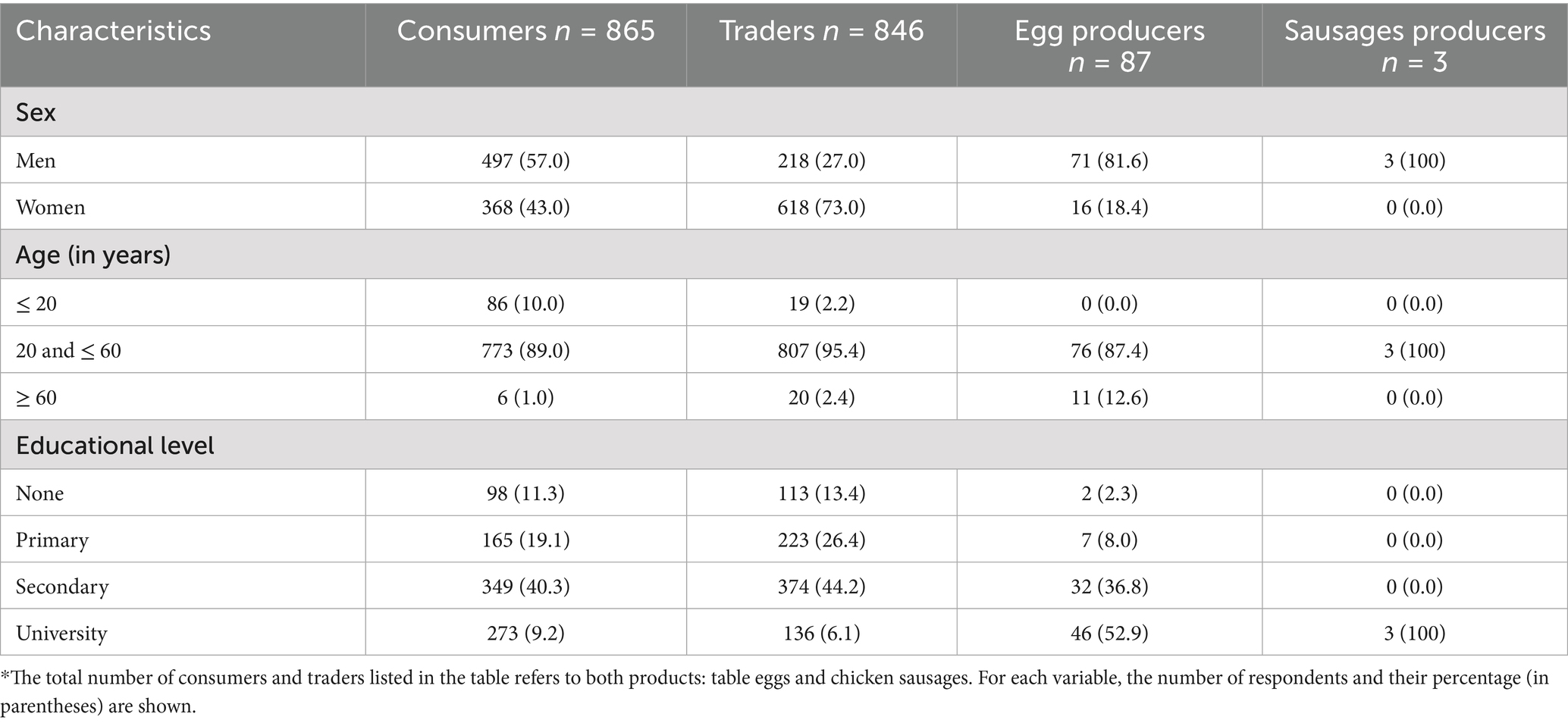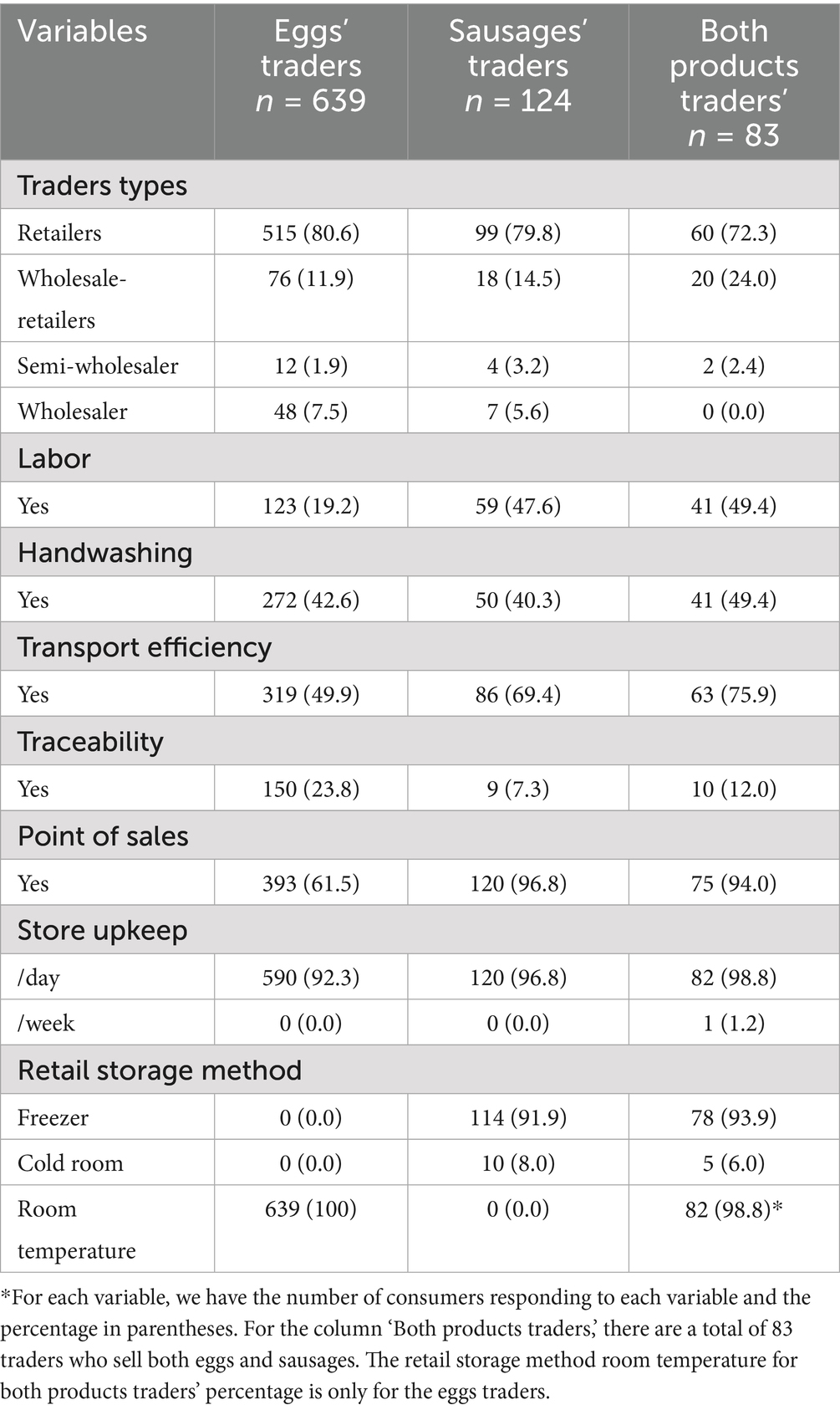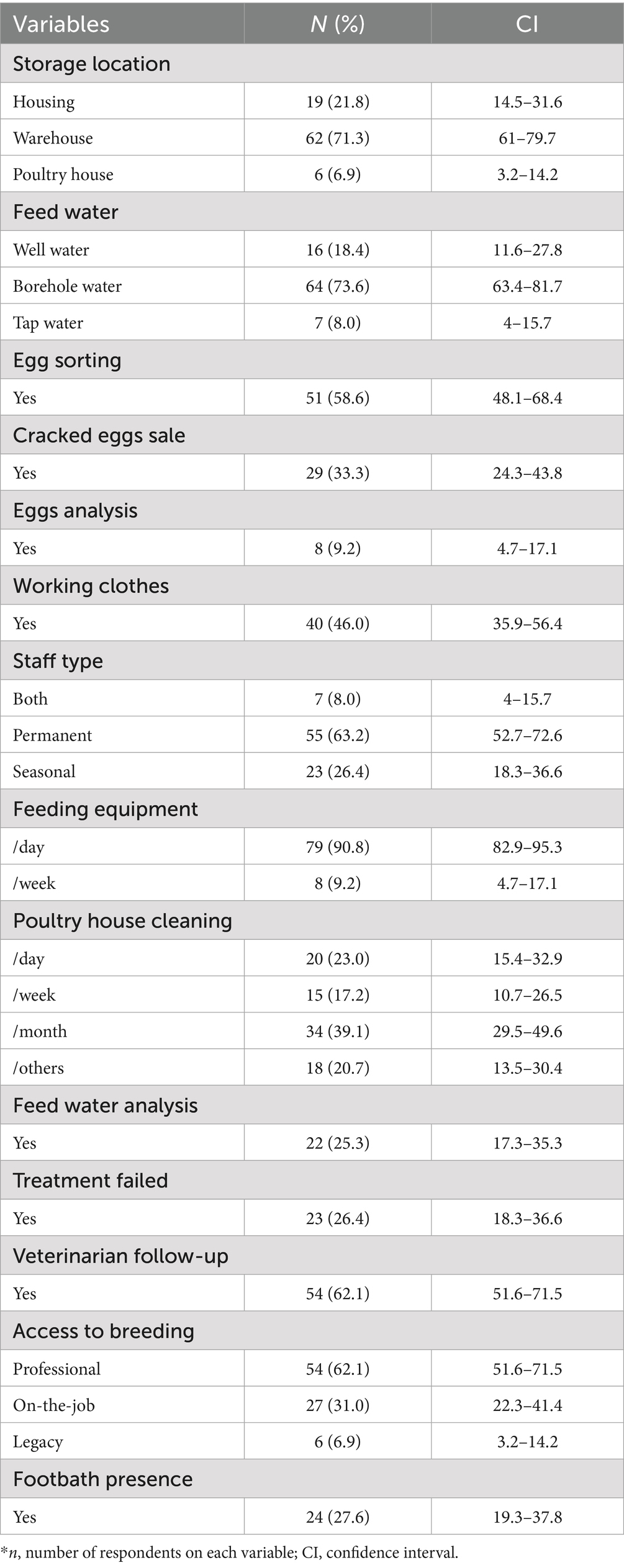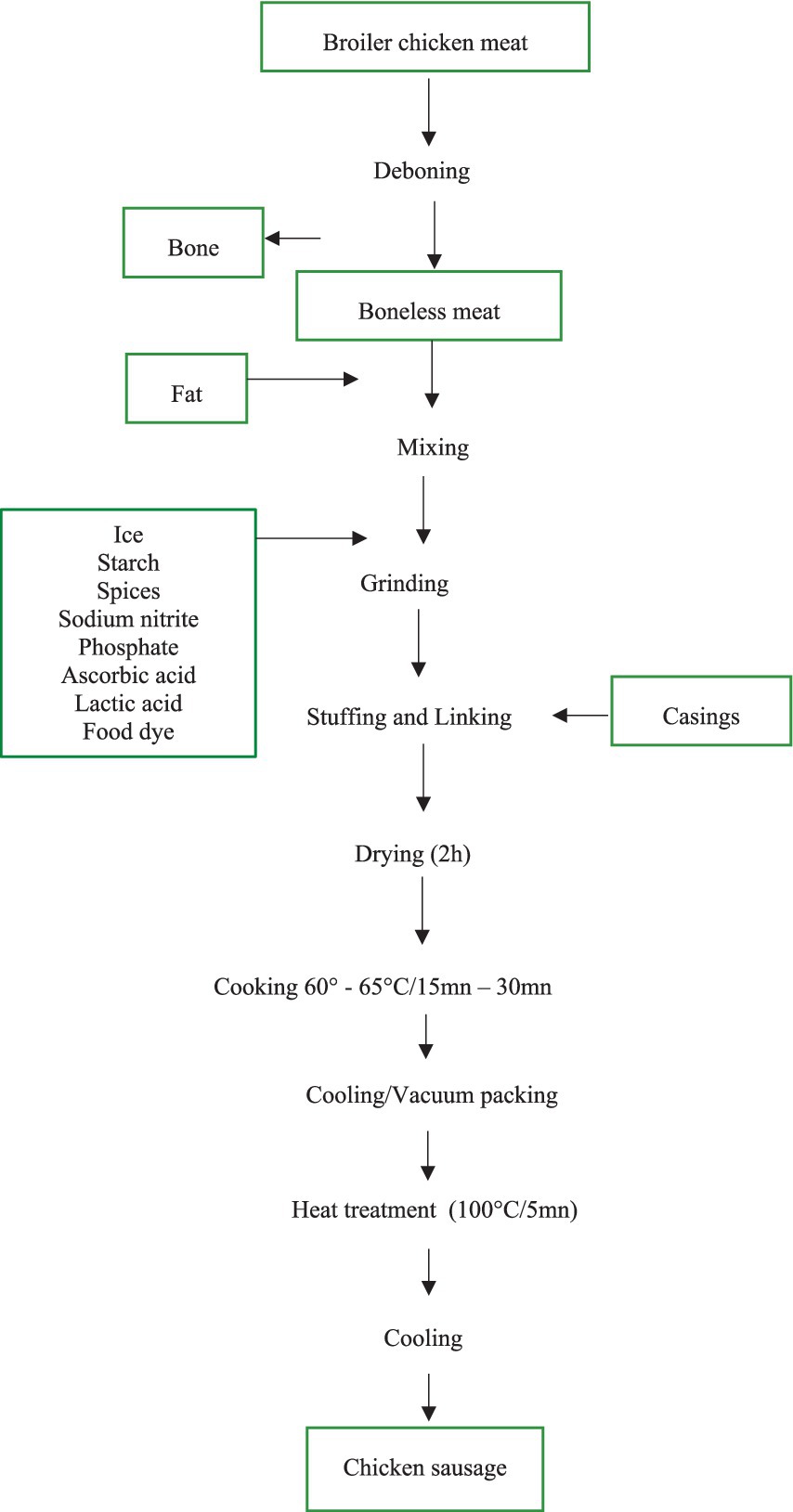- 1Communicable Diseases Research Unit, Laboratory of Research in Applied Biology, Polytechnic School of Abomey-Calavi, University of Abomey-Calavi, Cotonou, Benin
- 2Department of Food Sciences, Faculty of Veterinary Medicine, FARAH-Veterinary Public Health, University of Liege, Liege, Belgium
- 3Laboratory of Food Sciences and Technology, Faculty of Agronomic Sciences, University of Abomey-Calavi, Cotonou, Benin
Background and objectives: Eggs and poultry sausages are widely consumed in Benin due to their affordability and high protein content. Nevertheless, inadequate hygiene practices during production, marketing, distribution, and consumption may pose significant food safety risks. This study assessed hygiene practices across these value chains.
Methods: A cross-sectional survey was conducted and involved 1801 stakeholders across five departments in Benin. Data were collected via a digitized, semi-structured questionnaire administered via Kobocollect. The survey data was structured in Excel and then analyzed using R software to calculate frequencies and to cluster similar profiles among different stakeholders.
Results: Among the interviewers, egg consumption was 81.5%, compared to 5.9% for sausages. Three primary consumption methods were observed: boiling (87.2%), frying (71.9%), and raw (3.47%) for eggs. Regarding hygiene practices, 66.5% of handlers wash their hands before handling eggs, and 93.6% of selling locations are cleaned daily. However, eggs are transported under conditions that do not preserve their integrity, which may affect their quality when they reach consumers. Additionally, some eggs production farms engage in problematic practices such as antibiotic misuse and selling products without prior testing. Beyond eggs, the most common consumption method for sausage is frying (17.7%). Sausage production varies in processing diagrams, but hygiene and production practices are generally respected. However, significant concerns remain, regarding cold chain compliance, as sausages are not stored under appropriate temperature conditions. The study highlights the need to raise awareness among stakeholders within the poultry industry regarding the importance of adhering to good hygiene practices and their impact on public health.
1 Introduction
The consumption of livestock products is increasing globally. Eggs and poultry sausages, in particular, are significant dietary components for populations worldwide, especially in low and middle-income countries (LMICs). Their affordability makes them widely accessible to diverse populations in these nations, often serving as staple meat-based options. Benin’s agricultural and livestock sector boasts strong economic potential, with over 356,100 laying hens recorded (Direction de la Statistique Agricole (DSA-Benin), 2021). Egg production is a valuable asset for poverty reduction and the national economy, contributing a significant 5.7% to Gross Domestic Product (GDP) (Houedjofonon et al., 2019). However, Benin struggles to meet its demand for animal protein. According to the Food and Agriculture Organization (FAO), per capita consumption of animal protein sits at 12 kg/person per year, falling below the recommended minimum of 20 kg/person per year (FAO, 2015). To address this shortfall, Benin imported approximately 37,360 tonnes of edible meat and offal in 2022, including 2,820 tonnes of sausages (Tridge, 2022; INStaD-Bénin, 2023). Eggs are favored for their high-quality protein and lipid content and their richness in vitamins and minerals (Nau et al., 2016). Sausages, as one of the most prevalent processed meat products globally, provide nutrients that cater to the dietary needs of individuals across various age groups (Güemes-Vera et al., 2018; Houmy et al., 2020). World Health Organization statistics suggest that, worldwide, over 600 million people fall ill annually from consuming foodborne pathogens, particularly those of animal origin (Six et al., 2012; FAO and OMS, 2018; Hanafi et al., 2023). Foodborne illnesses remain a significant public health concern, with Salmonella being a predominant causative agent. Salmonella Enteritidis and Typhimurium are the main serovars associated with human salmonellosis, particularly from poultry products like eggs (Chousalkar and Willson, 2022). Raw sausages can also pose a risk for Toxoplasma gondii infection, although the probability is low (Abdulmawjood et al., 2014). Products rich in essential nutrients, while beneficial for health, can also provide a favorable environment for the growth of pathogenic microorganisms if storage or processing conditions are not optimal. This can lead to a decline in their quality and increase the risk of foodborne outbreaks, such as septicaemia, diarrheal diseases, or other potentially severe, even life-threatening complications (EFSA, 2025). In Benin, the poultry industry is characterized by a predominance of small-scale farms with very little access to finance, and low levels of biosecurity, and most of these farms operate informally without following any procedure or regulations (Pougoue et al., 2019; Awad et al., 2023). Chicken sausage production is a booming sector, with the emergence in recent years of units processing poultry meat into thin-cut sausages and merguez (Kabore et al., 2022). Given its innovative nature some adjustments need to be made in terms of hygiene and production technology, as sausages can be contaminated by microorganisms from equipment, environment staff and/or spices (Güngör and Gököglu, 2010). The growth of the egg and chicken sausage production sector in Benin offers major economic opportunities. However, the development of this sector is restricted by a lack of scientific data on the practices of the value chain stakeholders and on consumer expectations in terms of quality and safety. This article aims to compile a scientific data package to raise awareness among stakeholders involved in the value chains of table eggs and sausages. The package will analyze hygiene practices throughout the processing steps, distribution, and marketing of these products, while highlighting the health risks associated with current consumption patterns in Benin.
2 Materials and methods
2.1 Characteristics of study area
The present study was conducted in five departments within Benin’s southwestern region: Atlantique, Littoral, Mono, Couffo, and Oueme (Figure 1). These five departments are grouped into two Agricultural Development Poles (ADPs). Their selection was based on their high poultry product productivity and consumption levels (Direction de la Statistique Agricole (DSA-Benin), 2021).
2.2 Data collection and participant selection
A descriptive cross-sectional study was undertaken, involving a range of stakeholders. These included eggs and sausages producers, traders of both products, and consumers of eggs and sausages. To facilitate data collection, the digitized Kobocollect tool was used, ensuring a structured approach. Due to incomplete producer lists available, and the absence of any lists for sausage producers in the targeted departments, alternative methods were employed. Egg producers facilitated contact with counterparts in neighboring localities, using a “snowball sampling” technique (Dassou et al., 2018). Similarly, contacts with chicken sausage producers were established through local supermarkets. For retailers and consumers, sampling was carried out according to the formula described by Rea and Parker (1997), which determines sample size based on the target population, employing a 5% margin of error and a 95% confidence level. The questionnaire addressed various aspects, including hygiene practices during egg production, veterinary care for poultry, distribution, storage, and warehousing conditions for both products. Consumer habits regarding consumption and preservation were also explored. The study also investigated environmental hygiene practices throughout the production and sales chain, encompassing traders and farm managers. Finally, demographic data such as age, gender, and educational level were collected. Following a clear explanation of the research objectives, all participants provided informed consent to participate in the survey. Prior to deployment in the field, investigators underwent training and were equipped with digital questionnaires accessible on their smartphones.
2.3 Statistics analysis
Survey data underwent translation into a structured format before being uploaded to Microsoft Excel 2016. Subsequently, the data was imported into R software version 4.0.5 for statistical analysis. The following analyses were employed: Chi-square test: This test was employed to evaluate the independence between qualitative variables; Multiple Correspondence Analysis (MCA): MCA provided a visual representation through a graphical plot, allowing for the exploration of relationships between variables. Specifically, it examined the relationships between consumers and traders, visualized on planes defined by factorial axes; Hierarchical Ascendant Classification (HAC): Building upon the components derived from the MCA, HAC was applied to categorize traders and consumers into higher-order clusters based on the similarity of their profiles. Descriptive statistics: Descriptive statistics were calculated to summarize the quantitative variables characterizing the various stakeholder groups within the survey. The level of statistical significance was set at 5%.
3 Results
3.1 Socio-cultural characteristics of participants
The interviews, using various semi-structured questionnaires, brought together a total of 1,801 stakeholders spread across the five target departments, as shown in Table 1. Analysis of the demographic characteristics of the different stakeholders presented in Table 2, enabled us to note that at the consumer level (n = 865), 57% were men compared to 43% women, with age ranges from 20 years to ≥ 60 years and only 11.3% had no formal education. The marketing of both types of products turns out to be a female activity (73%), the majority (95.4%) of them are aged between 20 and 60, and 13.4% have no education. Moreover, table egg production is a male activity, with 87.4% of men between the ages of 20 and 60, and only 2.3% not attending school. Finally, all the sausage producers were male, aged between 20 and 60, and with higher education.

Table 1. Types of actors in the five areas during the survey on egg and sausage consumption in Benin.
3.2 Consumers’ characteristics, consumption patterns, and hygiene
Four (04) groups of stakeholders in terms of consumers and traders have been identified. Product consumed, the mode of consumption, compliance with hygiene practices, the places of supply and the frequency of consumption were used to classify consumers into the following groups: Group 1: Consumes only a few eggs and sausages; representing 7.4% of consumers; Group 2: Consumes more eggs than sausages; representing 74.2% of consumers; Group 3: Consumes more sausages than eggs; representing 13.1% of consumers; and Group 4: Consumes a same proportion of eggs and sausages; and represents 5.9% of consumers (Figures 2, 3). Furthermore, eggs are consumed significantly more than sausages, with consumption rates of 81.5% for eggs compared to 5.9% for sausages. However, 12.6% of respondents eat both products at the same time.
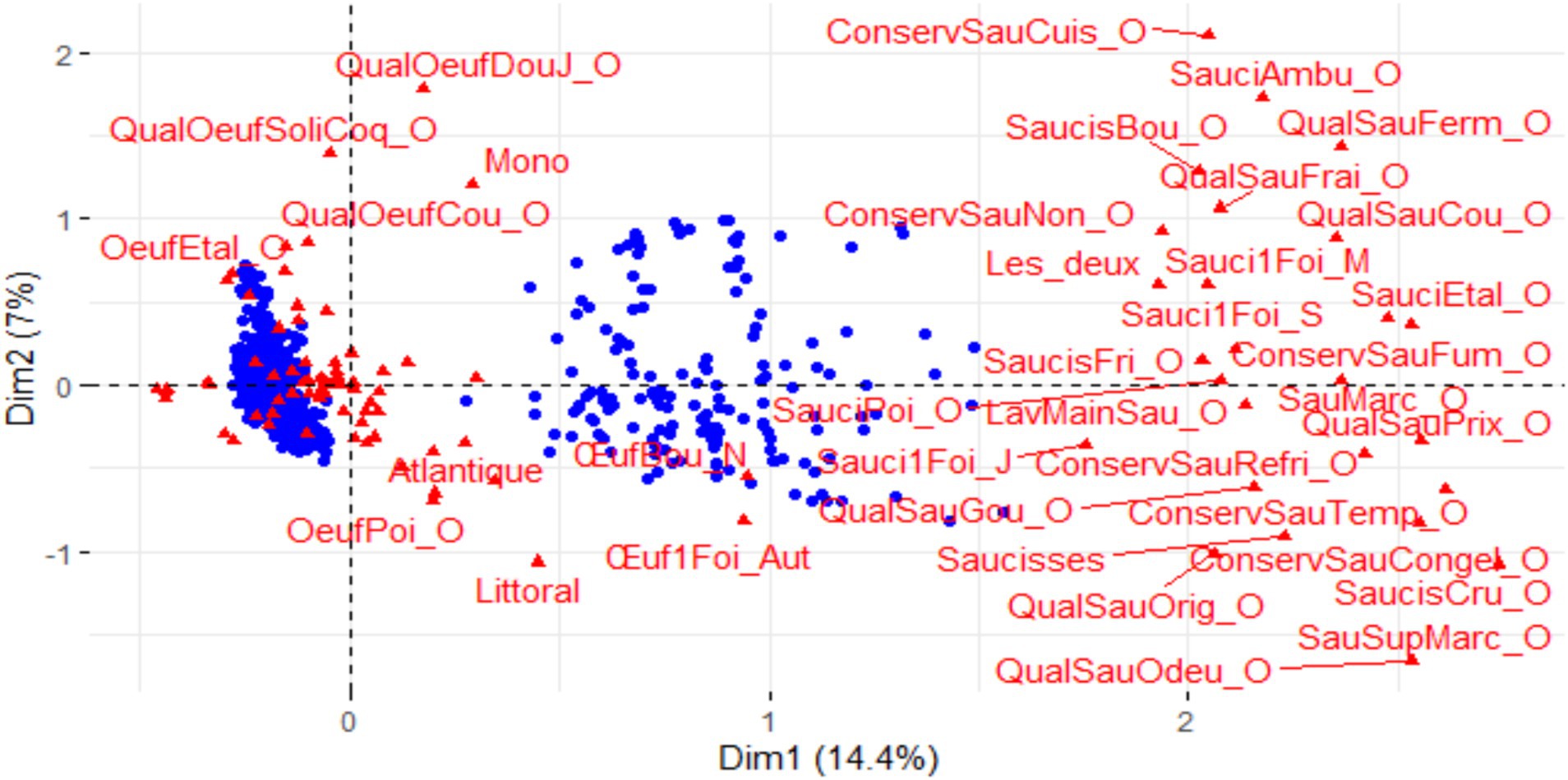
Figure 2. Multiple correspondence analysis (MCA) overlay visualizing the characteristics (red triangles) of surveyed table egg and sausage consumers (blue dots). The blue points represent consumers of eggs and poultry sausages, while the small red triangles represent the modalities on which the MCA analysis was performed. Modalities that are close to each other are positively correlated, share similar characteristics, and describe respondents from the same group.
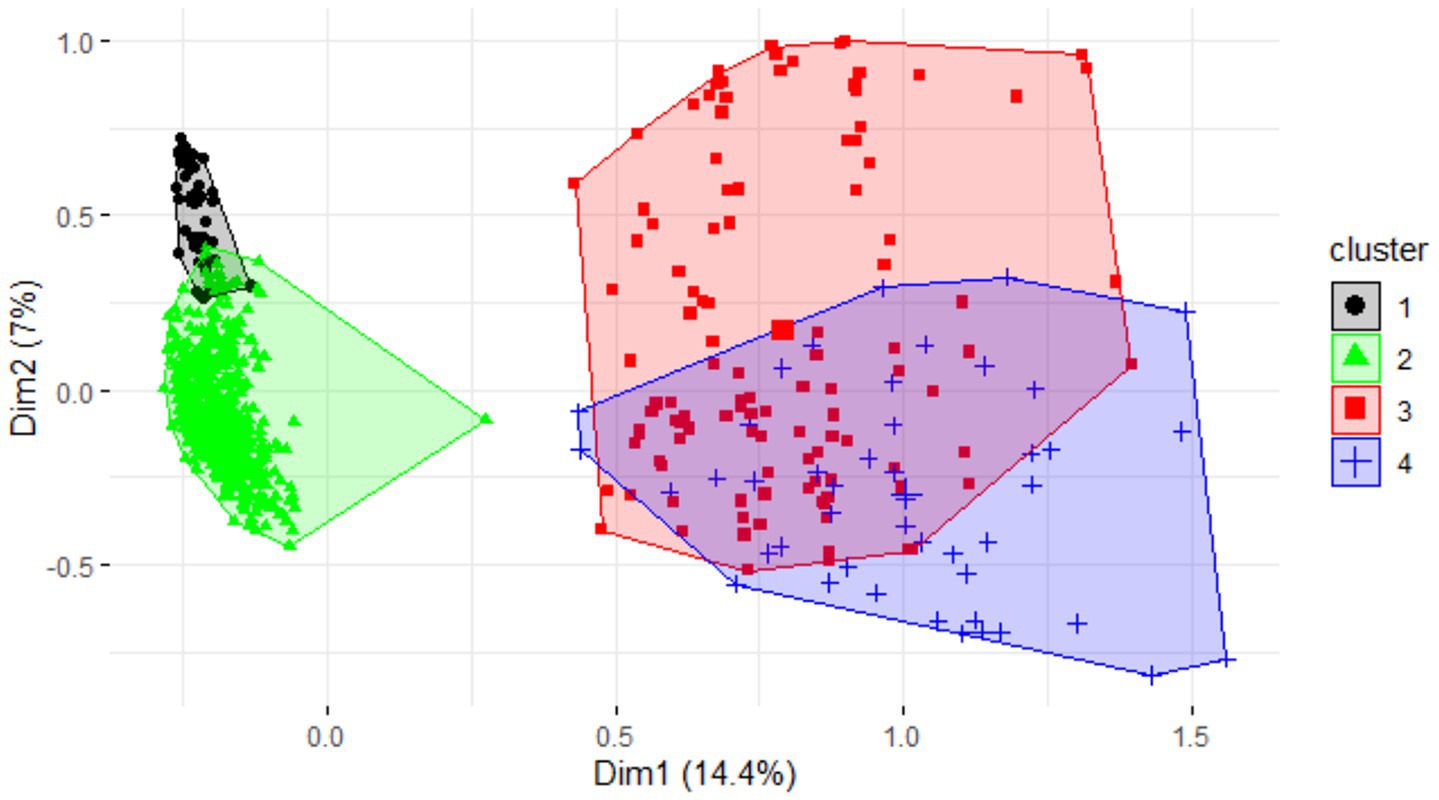
Figure 3. Consumer segmentation in the Benin table egg and Sausage market. Cluster 1: Consume few eggs and sausages; Cluster 2: Consume more eggs than sausages; Cluster 3: Consume more sausages than eggs; Cluster 4: Consume a same proportion of eggs and sausages; Clusters 1 and 2 consist of individuals who share similar practices in terms of consumption, hygiene habits, preservation methods, and product purchasing locations. Clusters 3 and 4 consist of individuals with more varied and heterogeneous practices.
The identified consumption patterns for eggs included ‘boiled’ (87.2%), ‘fried’ (71.9%), and ‘raw’ (3.5%). Weekly egg consumption was reported at 46.6%. Preservation methods employed by consumers consisted of refrigeration (7.9%) and storage at ambient temperature (56.0%), which in Benin Republic typically ranges between 28°C and 33°C. In terms of origin, 53.9% of eggs were sourced from markets. Handwashing practices, utilizing clean water or soap, were observed among 66.5% of egg consumers.
Analysis of consumption practices revealed that sausage preparation methods were distributed as follows: boiling (3.1%), frying (17.7%), and raw consumption (2.2%), with a weekly consumption frequency of 11.3% within the studied population; sausage preservation methods reported by consumers were classified as freezing (3.8%), refrigeration (4.4%), smoking (0.8%). Sausages origins were identified as 15.7% from establishments specializing in seafood, poultry, and offal, commonly known as fishmongers; and the practice of hand washing (with clean water or soap) before sausage consumption was observed in 13.8% of consumers.
About 9.2% of the consumers knew of the health risks associated with eating these two products without cooking (Table 3). They mentioned diarrhea, stomach ache, constipation, allergies and vomiting among the illnesses observed.
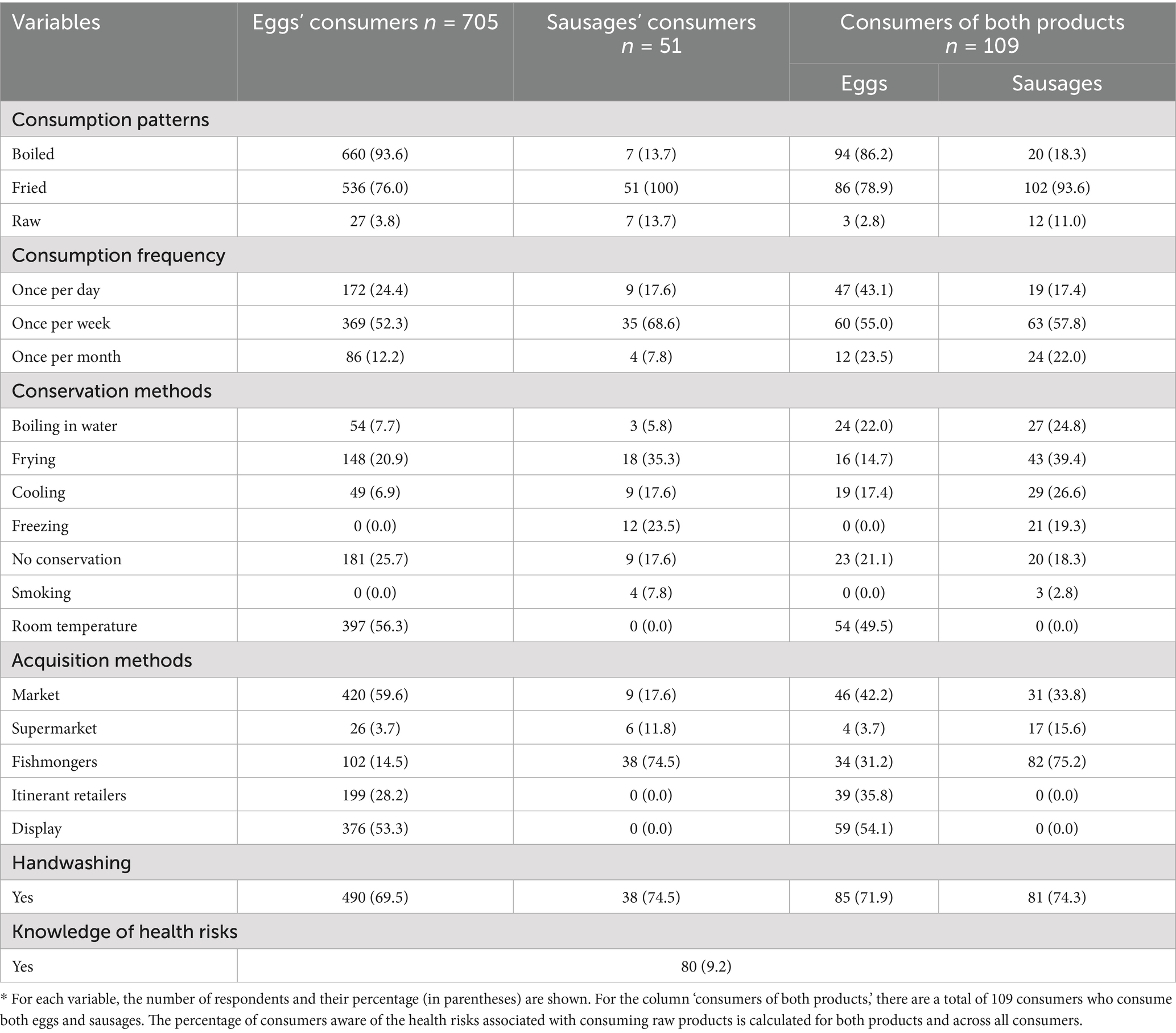
Table 3. Consumption and hygiene practices of people surveyed about table eggs and sausage in Benin.
3.3 Table eggs and chicken sausages distribution and transport
The multiple correspondence analysis (MCA), illustrated in Figure 4, followed by an ascending hierarchical classification (AHC), represented in Figure 5, was based on several factors, including the type of product, the method of storage, the quality of the products, the place of sale, the conditions of sale and the method of transporting the products.
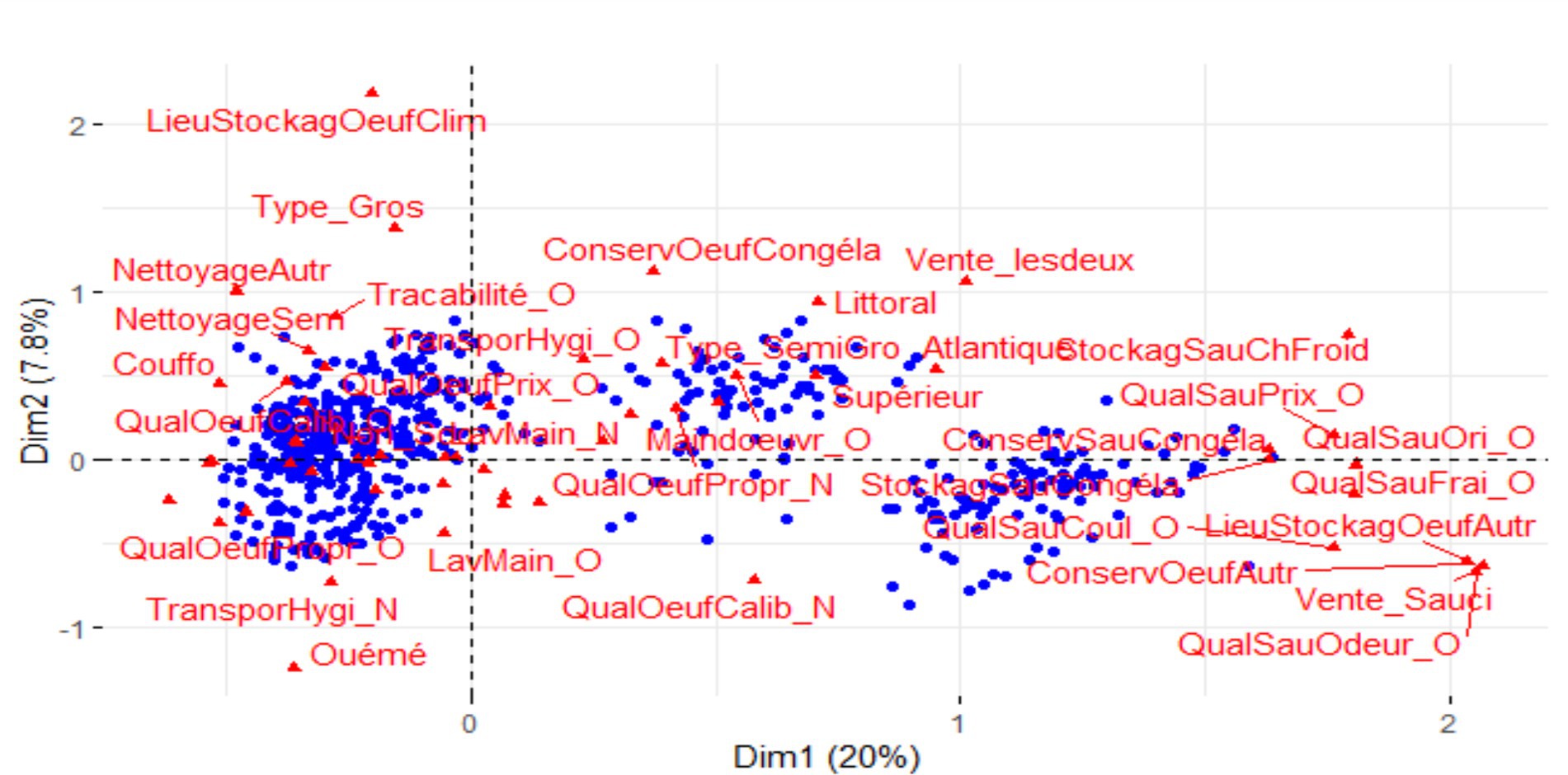
Figure 4. Multiple correspondence analysis (MCA) overlay depicting characteristics (red triangles) of surveyed table egg and sausage retailers (blue dots). The blue points represent eggs and poultry sausage sellers, while the small red triangles represent the modalities on which the MCA analysis was performed. Modalities that are close to each other are positively correlated, share similar characteristics, and describe respondents from the same group.
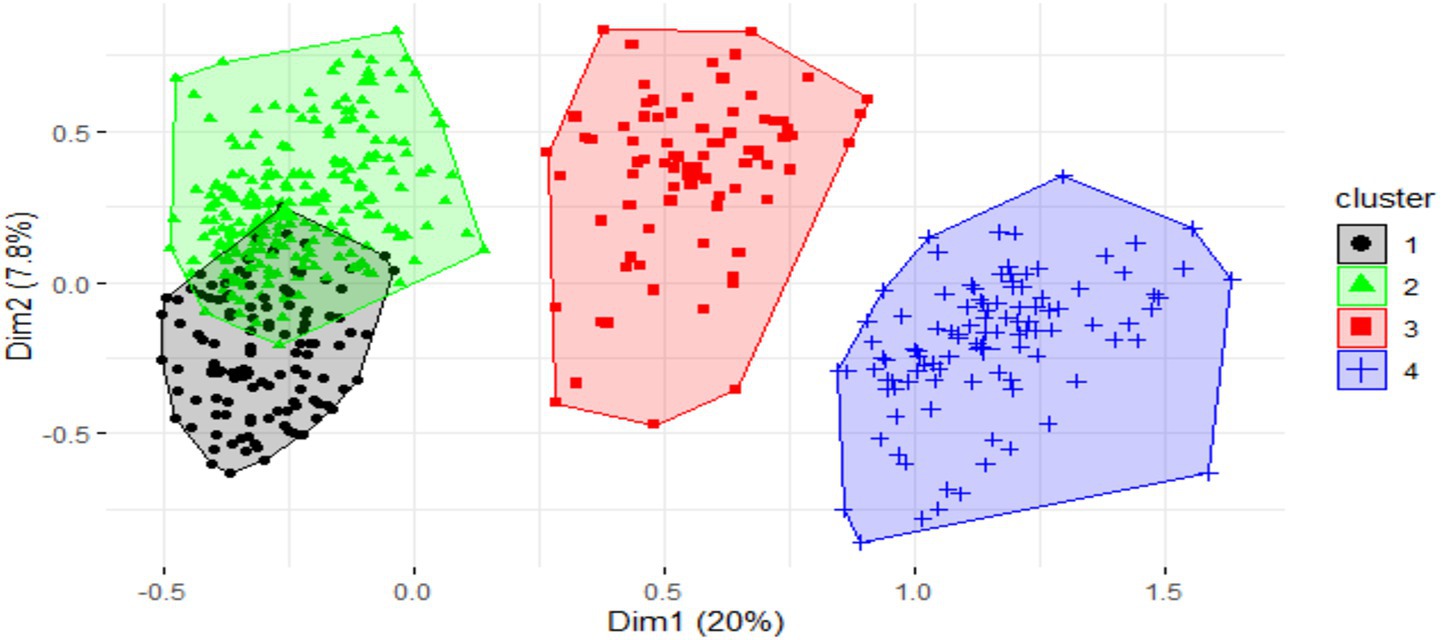
Figure 5. Characterisation of stakeholders in the Benin table egg and sausage marketing chain. Cluster 1: Retailers and wholesalers who sell only table eggs; Cluster 2: Sellers specialized in wholesale eggs sales; Cluster 3: Retailers who sell both products (eggs and sausages); and Cluster 4: Sellers of sausages only. Clusters 1 and 2 consist of individuals who share the same modalities based on the products sold. Clusters 3 and 4 are more heterogeneous and do not have common modalities as they do not sell the same categories of products.
Based on these factors, four groups of traders were identified. Group 1: Retailers and wholesalers who sell only table eggs, representing 33.3% of the respondents; Group 2: Sellers specialized in wholesale eggs sales, representing 42.1% of respondents; Group 3: Retailers who sell both products (eggs and sausages), representing 9.8% of respondents; and Group 4: Sellers of sausages only, representing 14.7% of respondents.
The commercialization of eggs and sausages is predominantly a women’s activity, with 73% of traders being women. Retailers constitute the majority of traders (76.7%), among whom 69.5% have a shelter, while the others are itinerant retailers without a fixed location. However, these shelters do not offer full protection against inclement weather (dust, sunlight, rain, etc.). The majority of traders (93.6%) report that they regularly clean their shelter (by sweeping). Transportation conditions for products are considered unsatisfactory by 44.7% of traders who report problems with damaged eggs (cracks or breakage) upon receipt. It should be noted that these products reach them via unsuitable means such as two-wheel motorcycles, tricycles, or taxis that are not exclusively used for transporting eggs. The duration of egg transportation varies depending on the proximity of the supply source. However, it ranges from 1 to 2 hours, or even more, and they are exposed to the sun and various weather conditions throughout the journey. As for the sausage trade, the cold chain is not respected. Moreover, storage conditions are irregular, with temperature checks primarily based on the appearance of the products (products are received? as frozen), rather than on specific temperature standards. To reduce the costs associated with the energy consumed by freezers, they are turned off during the day and turned back on in the evening depending on the trader and vice versa. Only 20% of traders are well aware of the origin of their products and possess traceability documents (Table 4).
3.4 Poultry breeding management and biosecurity
The study targeted 87 poultry farms specializing in layer hen farming. Among these poultry farmers, 62.1% had received professional training in poultry farming, either at agricultural high schools, state universities, or various specialized centers. The remaining proportion had on-the-job training (31%) or inherited the activity from their parents (6.9%).
The farming system on the majority of farms is semi-industrial (97.7%), and it is mainly floor farming. The size of the flocks of laying hens varies from 50 to 20,000 individuals, and egg production ranges from 50 to 18,000 units per day. The main source of water used on these sites is borehole water (73.6%), followed by well water (18.3%) and tap water (8.0%). Physico-chemical and bacteriological analysis of water is carried out by only 25.3% of farmers, while 74.7% do not consider this approach useful.
In terms of health monitoring, 62.1% of farmers rely on an independent veterinarian for occasional visits, while 38% carry out diagnoses and treatments themselves, most often based on experience acquired from their peers, by observing veterinary officers or in training centers. The symptoms observed in poultry, such as the characteristics of droppings or the behavior of the poultry, guide therapeutic decisions. The various veterinary products used by farmers include antibiotics from the beta-lactam, tetracycline, sulfonamide, polymyxin, quinolone, and fluoroquinolone classes. Among the latter, tetracyclines, and more specifically oxytetracycline, are frequently administered. In addition to these molecules, antiparasitics, hepatoprotectors, vitamins and minerals, anti-stress agents, anticoccidials and antiseptics or detoxifiers are used. In 26.4% of cases, farmers reported instances where the antibiotics administered did not achieve the expected therapeutic effect against certain pathologies. These therapeutic failures prompted some farmers to modify antibiotic treatments until satisfactory efficacy was attained.
However, the withdrawal periods after the administration of antibiotics before the commercialization of eggs are not always respected by farmers, especially during periods of high market demand. This, in addition to the issue of antibiotic resistance, can lead to the presence of antibiotic residues in the eggs being sold. For facility maintenance, 39.1% of farmers change the litter monthly, while others adopt varying frequencies.
The disinfectants used, such as bactericides, viricides, and fungicides, include products such as bleach, D4+, and TH4+, which are specifically formulated as disinfectant agents. These products were applied in accordance with the manufacturer’s recommendations.
The presence of footbaths was noted in 27.6% of farms, however they are not all functional. The different farms have two types of personnel, permanent (63.2%) and seasonal (26.4%) or even both (8%). The managers of the poultry farms are responsible for instructing and training these employees on the hygiene and farming practices to be respected. However, their main task is to ensure the feeding of the poultry and the collection of eggs. The wearing of clothing exclusively for the farming activity was identified in 46% of workers only.
Egg collection is carried out manually and daily, followed by sorting for 58.6% of farmers. This sorting process, which is done manually, is based on egg size (small, medium, large) or weight (55–60 g, 65–75 g, 80–85 g). The eggs are neither washed nor disinfected, and they are not marked in any way. They are stored in various locations: at ambient temperature (between 28°C and 33°C) in a store (71.3%), in a corner of the chicken coop (6.9%), or in the farmers’ dwellings (21.8%), for a maximum duration of 7 to 15 days, depending on market demand. Storage warehouses, for those who have them, are also used to store farming equipment (cages, buckets, medicines, feed, etc.) or to house the workforce present on the site. The eggs are stored and sold in cardboard or plastic egg trays.
Only 9.2% of farmers perform laboratory analyses on egg samples to evaluate microbiological quality before marketing, whereas the remaining 90.8% do not adopt this practice, largely due to financial limitations or a lack of interest. Moreover, authorized control agents tasked with sampling and analysis do not consistently visit all farms, prompting some farmers to take on the responsibility of collecting samples themselves. Even when these agents conduct analyses, the results are often not relayed back to the farmers.
The methods of delivering eggs to buyers vary, including the use of four- or three-wheel vehicles as well as motorcycles. Damaged eggs are also marketed, particularly to pastry shops, street food vendors and local populations, due to their reduced selling price. This practice is adopted by 33.3% of farmers (Table 5).
3.5 Sausage production and biosecurity practices
Three chicken sausage producers were identified in the Littoral department, highlighting the emergence of a new and promising activity in Benin. These producers manufacture an average of 20 to 60 kg of sausages per day, using poultry meat, mainly chicken from local farmers. Sausage production involves the use of synthetic (prefabricated edible collagen or cellulose casings) and natural casings (from sheep or pork). Various ingredients, such as spices and additives, are added to enhance the taste and texture of the sausages, which are popular with consumers. None of the producers use preservatives for their products. The main heat treatments applied to the products to prevent contamination are cooking. Those cooking parameters vary from one producer to another (50°C/30 min, 65°C/15 min, and 60°C/30 min), with all producers applying heat treatment at 100°C for 5 to 10 min.
The different steps of sausage processing are shown in Figure 6. According to the producers, the equipment and production area undergo cleaning and disinfection before and after every production cycle. They also highlighted that the infrastructure is specifically designed to support these operations, featuring tiled floors and surface coverings for easy maintenance. Regarding waste management, producers have established contracts with specialized services for the regular collection of waste, separated into organic and non-organic categories, thus ensuring efficient management in compliance with environmental standards. Finally, the sausages are either frozen to ensure their preservation before being marketed or, in the case of one producer, delivered directly to restaurants, their main customers.
4 Discussion
4.1 Table eggs and sausage consumption
This investigation focused on four key stakeholders within the Benin food system: consumers, egg and sausage producers and retailers. Data revealed a marked preference for eggs over sausages, aligning with the observations of Réhault-Godbert et al. (2017). Consumer responses highlighted concerns regarding the origin and quality of meat used in sausage production, with a significant portion being imported. Additionally, anxieties were expressed surrounding the duration and storage conditions of sausages, along with the inclusion of numerous food additives. Conversely, eggs were perceived as advantageous due to their local production, fresh appearance, and purportedly higher nutrient content.
The study identified two predominant egg consumption patterns in Benin: “boiled” and “fried.” These methods are corroborated by previous research conducted by Batonon-Alavo et al. (2015), Nau et al. (2016), Hounkpe et al. (2023), and Ossamulu et al. (2023). Notably, these consumption practices are recognized to enhance food safety stability and extend the shelf-life of eggs (Prache et al., 2023). Unlike in other regions where the consumption of raw eggs is gaining popularity due to perceived benefits, such as nutrient preservation and the alleviation of certain health issues like anemia (Ossamulu et al., 2023), raw egg consumption remain uncommon in Benin and is generally associated with specific cultural health beliefs.
In terms of sourcing, consumer preference leaned toward traditional markets over supermarkets. This selection was attributed to factors such as proximity and perceived cost-effectiveness. However, supermarkets were acknowledged to offer benefits in terms of product storage and preservation conditions, facilitated by specific packaging and environmental controls like air-conditioning. Conversely, markets potentially expose eggs to various environmental factors, including wind, dust, and sunlight, which could compromise their quality. Previous studies reported, the detrimental effects of inadequate storage conditions on eggs, including albumen liquefaction and physicochemical alterations (Karib et al., 2021). Furthermore, (Hassan et al., 2023) emphasized the importance of maintaining specific storage temperatures around 7°C, particularly in regions with ambient temperatures (37–40°C).
Interestingly, our data showed that handwashing was more frequent after handling eggs than after handling sausages. This difference may be explained by the fact that sausages were pre-cooked, making handwashing seem less necessary after handling them. This behavior was attributed to heightened concerns about potential contamination, despite the prevalence of universal food hygiene standards. However, it is well-established that handwashing before food preparation remains a critical preventative measure for reducing the transmission of infectious and contagious diseases such as diarrhea, dysentery, and typhoid fever (Qazi and Anwar, 2021; Gizaw et al., 2023). It is noteworthy that the observed lack of widespread awareness regarding health risks associated with raw egg consumption may be partially explained by the dominant practice of cooking eggs (boiling or frying) in Benin.
4.2 Table eggs and sausage distribution
Direct sales to consumers through retail channels constitute the predominant mode of table egg and sausage distribution in Benin, surpassing wholesale transactions. This observation is consistent with the earlier work of Mopate and Bebanto (2009), who reported that retail outlets accounted for 78.7% of egg vendors, compared to 7.9% operating at the wholesale level. Inefficiencies within the transportation infrastructure lead to a significant challenge to the integrity of the supply chain. Deteriorated road conditions leading to poultry farms, coupled with inappropriate packaging and rudimentary means of transport, contribute to substantial losses upon delivery of eggs. Disruption of the cold chain presents the primary concern for sausages. Retailers, lacking access to refrigerated transportation options such as trucks or tricycles, frequently resort to utilizing unprotected modes of transport, exemplified by motorcycle taxis. Furthermore, the multi-purpose nature of these transportation methods, often employed for various goods without proper disinfection protocols, creates additional public health risks (Karib et al., 2021).
Retailers selling sausages often struggles to monitor and maintain the proper storage temperatures, both for the products and the freezers they use. This lack of awareness, compounded by the desire to minimize energy expenditure, can lead to the practice of switching off freezers during the day. Such practices significantly elevate the risk of product contamination and subsequent deterioration in organoleptic quality.
4.3 Table eggs production and biosecurity
This investigation identified significant shortcomings in the implementation of biosecurity protocols within poultry farms across Benin. Deficiencies in biosecurity practices heighten the risk of pathogen transmission from poultry to humans, posing a potential public health concern. Our on-farm observations revealed a concerning lack of functional footbaths in 72.4% of farms surveyed. The absence of this biosecurity measure hinders efforts to control the introduction and spread of microbial contaminants within poultry production units. This figure surpasses the non-compliance rate reported by Panda et al. (2023), where 68.3% of farmers acknowledged the value of footbaths for infection control at farm entrances.
Despite a flourishing egg production industry in both urban and rural areas, poultry farmers grapple with numerous challenges. These challenges encompass a dearth of qualified personnel and limited financial resources (Pougoue et al., 2019) suggested that the limited number of qualified individuals within the poultry sector often pursue independent ventures or seek employment within the public sector. Notably, egg production in Benin emerges as a predominantly male-driven activity, diverging from observations in other African nations such as Algeria, Morocco, Mauritania, and Egypt, where Fagrach et al. (2023) documented a more significant role played by women.
The majority of farms rely on borehole water, with very few conducting bacteriological analyses to verify its cleanliness. This observation aligns with the findings of Aungon and Falculan (2023) and Suleiman and Sani (2023). The absence of routine water disinfection poses a significant public health risk. Poultry manure within farms can contribute to nutrient leaching and harbor pathogens such as Salmonella spp. and Escherichia coli, potentially contaminating water reserves and exposing both humans and animals to various diseases (Akporube et al., 2023).
The systematic allocation of work clothes among farm personnel was not observed. This contrasts with the findings of Ayim-Akonor et al. (2020) in Ghana, where a significant portion of surveyed farmers utilized work attire and practiced handwashing after farm activities. Consistent work clothes and hand hygiene practices are crucial for preventing the emergence of zoonotic diseases. Livestock monitoring practices also exhibited several irregularities. Notably, some farmers administer antibiotics without consulting veterinarians. While over half receive veterinary oversight, they often seek assistance only for issues beyond their expertise. Reliance on personal experience, peer advice, or recommendations from veterinary pharmacy assistants is not uncommon, leading to the improper use of antibiotics and potentially contributing to the development of antibiotic resistance. This finding is consistent with the observations of Ahmad et al. (2023), Sawadogo et al. (2023), and Siddiqui et al. (2023), who all documented the misuse of antibiotics by farmers and their lack of awareness regarding the associated health risks.
The practice of collecting eggs two to three times daily to prevent contamination and deterioration by poultry was deemed satisfactory by most farmers. However, additional measures are necessary to ensure safe egg storage. These measures include maintaining appropriate storage conditions and ensuring adequate ventilation within storage areas. Unfortunately, our observations revealed a lack of dedicated storage facilities, with eggs being stored in various unsuitable locations such as warehouses, corners of poultry houses, or even multi-purpose spaces within residences (used for storing cleaning products and/or as a resting place for personnel). Furthermore, the majority of storage spaces, including those in warehouses and residences, lack proper ventilation, potentially leading to the development of hot spots and subsequent egg deterioration.
Concerning gaps were identified in the management of damaged eggs. A significant proportion (33.3%) of producers were observed selling cracked eggs, which pose a potential contamination risk. These eggs are unsafe for human consumption and represent a potential source of exposure to various potentially pathogenic bacteria such as Escherichia coli, Salmonella spp., and Staphylococcus aureus (Karib et al., 2021). The sale of damaged eggs highlights a lack of awareness among farmers and traders about the potential health risks to consumers. This practice, coupled with the fact that most farmers (89.7%) do not conduct pre-market microbiological testing due to financial constraints and limited access to quality control centers in some regions, raises concerns about food safety.
According to Commission Regulation (EC) No 589/2008 of 23 June 2008 on marketing standards for eggs, aspects such as regular health checks on farms, laboratory analysis, classification, labelling, packaging, and record-keeping to facilitate traceability in the event of health problems are necessary for the marketing of eggs in the European Union. However, in Africa, and more specifically in Benin, the poor organization of the poultry farming system, characterized by the non-exhaustive inventory of poultry farms, the lack of rigorous monitoring of farms by qualified agents, poor access to finance and unfair competition due to the informal import of table eggs, are some of the many factors that prevent the effective implementation of monitoring systems, control of egg health quality, and product recalls in the event of irregularities.
4.4 Sausage production and biosecurity
Imported products currently dominate sausage consumption in Benin; nevertheless, a promising new sector is emerging with the establishment of three local poultry sausage producers.
This phenomenon mirrors a similar dynamic observed in other sub-Saharan African countries, as evidenced by Kabore et al. (2022) in Burkina Faso. Notably, all three surveyed local producers have received training in charcuterie, which suggests that they possess the necessary skills to comply with hygiene and quality standards in production. Despite the training received, these businesses are still new, and the managers do not always master all the critical aspects of food processing, particularly the management of critical control points needed to prevent bacterial contamination. Furthermore, only one of the businesses adheres to the principle of “forward progression,” while in the other businesses, this essential principle is not properly implemented, which could increase the risk of contamination through equipment, surfaces, or employees. Local businesses are not subject to regular health inspections, which may allow contaminated products to slip through. Only one producer conducts a routine microbiological analysis of their sausages. The remaining producers deem these analyses non-essential due to cost considerations and the relatively small-scale production volumes. Additionally, the lack of regular sanitary inspections by public health authorities raises concerns. These sausages are primarily produced using broiler chicken meat, sourced from local poultry farms in Benin. However, sausage production units often lack detailed information about the farming conditions, such as the use of antibiotics, feed quality, or potential contamination risks associated with these chickens. This gap in traceability and oversight underscores the need for stricter regulations and improved transparency in the supply chain.
As highlighted by Gbaguidi et al. (2020), the composition of sausages can promote the proliferation of pathogenic bacteria. In this study, locally produced chicken sausages exhibited a pH range of 5.9 to 6.3, with the reduction in pH attributed to the addition of salt and ascorbic acid, which enhance acidity and inhibit the growth of spoilage microorganisms, particularly neutrophilic bacteria that thrive optimally at a near-neutral pH. However, cooking temperatures in this context ranged from 50 to 65°C, failing to achieve the recommended internal temperature of 72°C for optimal safety and shelf life (Bueno et al., 2025). Additionally, two producers used natural casings, raising concerns about inadequate cleaning and sterilization processes. According to EFSA reports, while the risk of BSE from bovine casings is considered very low, it is not negligible, necessitating strict safety measures (EFSA, 2009). Collectively, these factors indicate that local sausage producers do not yet fully master the manufacturing processes, highlighting the need for improved technical knowledge, stricter regulations, and enhanced quality control to ensure product safety and consumer confidence.
Studies, such as the one conducted by Hachemi et al. (2023), report 22.3% case of foodborne illness due to sausage consumption with 8.1% of sick consumers hospitalized in Algeria. Additionally, an investigation into a methemoglobinemia outbreak in Thailand linked to sausage consumption reported eight hospitalized cases with no fatalities, where affected individuals exhibited acute central cyanosis and hypoxemia (Sangsawang et al., 2022). Therefore, despite the potential of the local Beninese sausage production sector, it is imperative to implement stricter controls and regulations. These measures are necessary to safeguard consumer health and ensure the long-term reputation of this emerging industry.
5 Conclusion
Animal products, particularly eggs and sausages, are important protein sources derived from meat, offering high nutritional value and widespread availability. This study investigates hygiene practices within specific segments of Benin’s poultry industry, encompassing production, distribution, and consumption. Eggs are the most prevalent product within this category. However, significant deficiencies in distribution and production practices highlight a knowledge gap regarding hygiene and production regulations among stakeholders. Given the sector’s economic significance, collaborative efforts are necessary to revitalize activities and address the various constraints faced by egg producers. These constraints primarily relate to technical expertise, effective monitoring systems, and access to subsidies. Furthermore, promoting local sausage production offers an opportunity to reduce reliance on imported sausages. To comprehensively assess the sanitary quality of these products and evaluate the impact of environmental factors on their characteristics, laboratory analyses are essential.
Data availability statement
The raw data supporting the conclusions of this article will be made available by the authors, without undue reservation.
Author contributions
CH: Conceptualization, Investigation, Methodology, Writing – original draft, Writing – review & editing. PS: Conceptualization, Data curation, Funding acquisition, Investigation, Methodology, Project administration, Supervision, Writing – review & editing. NN: Data curation, Formal analysis, Software, Writing – review & editing. PA: Data curation, Methodology, Supervision, Validation, Writing – review & editing. GD: Conceptualization, Data curation, Methodology, Supervision, Validation, Writing – review & editing. NK: Conceptualization, Data curation, Funding acquisition, Methodology, Project administration, Resources, Supervision, Validation, Writing – review & editing.
Funding
The author(s) declare that financial support was received for the research and/or publication of this article. ARES-CCD (Academy of Research and Higher Education of Commission for Development Cooperation) funded this study through an exceptional doctoral scholarship.
Acknowledgments
The authors would like to thank the ARES-CCD (Academy of Research and Higher Education of the Commission for Development Cooperation) for its support in the realization of this study through the financing of an exceptional doctoral scholarship. They would also like to thank the stakeholders of the sector for their support and availability.
Conflict of interest
The authors declare that the research was conducted in the absence of any commercial or financial relationships that could be construed as a potential conflict of interest.
Generative AI statement
The authors declare that no Gen AI was used in the creation of this manuscript.
Publisher’s note
All claims expressed in this article are solely those of the authors and do not necessarily represent those of their affiliated organizations, or those of the publisher, the editors and the reviewers. Any product that may be evaluated in this article, or claim that may be made by its manufacturer, is not guaranteed or endorsed by the publisher.
References
Abdulmawjood, A., Rosa, S., Taubert, A., Bauer, C., Failing, K., Zahner, H., et al. (2014). Investigation of persistence of infectious toxoplasma gondii in raw sausages using in-house developed and validated real time-PCR. Meat Sci. 97, 542–547. doi: 10.1016/j.meatsci.2014.03.008
Ahmad, B., Samad, A., and Hamza, M. (2023). Antibiotic resistance in poultry and farm animals and its solution. Biol. Times 2, 3–4.
Akporube, K. A., Kalu, E., Ikpendu, C., and Edward, I. G. (2023). Poultry waste management in Nigeria: a neglected sector. J. Sustain. Vet. Allied Sci. 4, 137–145. doi: 10.54328/covm.josvas.2023.123
Aungon, C. S., and Falculan, D. K. N. (2023). A study on the performance of poultry farmers in Odiongan, Romblon. Int. J. Res. Anal. Rev. 10, 246–254.
Awad, E. I., Abdlaal, S. F., Bayoumi, M. A., and Halawa, S. M. (2023). Microbiological and chemical studies on edible fresh table eggs. J. Adv. Vet. Res. 13, 1084–1089. Available at: https://advetresearch.com/index.php/AVR/article/view/1365
Ayim-Akonor, M., Krumkamp, R., May, J., and Mertens, E. (2020). Understanding attitude, practices and knowledge of zoonotic infectious disease risks among poultry farmers in Ghana. Vet. Med. Sci. 6, 631–638. doi: 10.1002/vms3.257
Batonon-Alavo, D. I., Bastianelli, D., Chrysostome, C. A. A. M., Duteurtre, G., and Lescoat, P. (2015). Sécurisation des flux d’approvisionnement en matières premières et de mise en marché des produits dans le secteur avicole: cas de la filière œufs au Bénin. Rev. Elev. Med. Vet. Pays Trop. 68, 3–18. doi: 10.19182/remvt.20571
Bueno, L. O., Dinali, D. L., Ramos, A. d. L. S., and Ramos, E. M. (2025). Development of poultry sausages utilizing manually and mechanically deboned meat from spent laying quails. Poultry 4:5. doi: 10.3390/poultry4010005
Chousalkar, K. K., and Willson, N.-L. (2022). Nontyphoidal Salmonella infections acquired from poultry. Curr. Opin. Infect. Dis. 35, 431–435. doi: 10.1097/QCO.0000000000000876
Dassou, S. S., Wade, I., and Agbangba, C. E. (2018). Typologie et rentabilité des systèmes de production laitière à Linguère au Sénégal. Int. J. Biol. Chem. Sci. 11, 2163–2176. doi: 10.4314/ijbcs.v11i5.18
Direction de la Statistique Agricole (DSA-Benin). (2021). Recensement National de l’agriculture 2019. Vol. 4. National Institute of Demographic Statistics in the Republic of Benin. Available at: https://instad.bj/images/docs/insae-statistiques/enquetes-recensements/RNA/Resultats-Module-base/VOLUME%204%20SYNTHESE%20DES%20PRINCIPAUX%20RESULTATS%20.pdf (Accessed Octobre 2021).
EFSA (2009). Scientific opinion on BSE risk in bovine intestines. EFSA J. 7:1317. doi: 10.2903/j.efsa.2009.1317
EFSA (2025). Foodborne zoonotic diseases. Available online at: https://www.efsa.europa.eu/en/topics/topic/foodborne-zoonotic-diseases (Accessed February 10, 2025).
Fagrach, A., Fellahi, S., Challioui, M. K., Arbani, O., El Zirani, I., Kichou, F., et al. (2023). Backyard poultry flocks in Morocco: demographic characteristics, husbandry practices, and disease and biosecurity management. Animals 13:202. doi: 10.3390/ani13020202
FAO (2015). Secteur Avicole Bénin. Revues nationales de l’élevage de la division de la production et de la santé animales de la FAO. No. 10. Rome: FAO.
FAO and OMS. (2018). Fardeau que représentent les maladies d’origines alimentaire et effets positifs de l’investissement dans la sécurité sanitaire des aliments. Available online at: https://www.fao.org/3/CA2809FR/ca2809fr.pdf (Accessed April 1, 2023).
Gbaguidi, M., Degnon, R. G., Konfo, T. R. C., Kpatinvoh, B., and Baba-Moussa, F. (2020). Improvement in sausage manufacturing process and potential use of selected aromatic plants as their bio preservatives in Benin. GSC Biol. Pharm. Sci. 11, 166–176. doi: 10.30574/gscbps.2020.11.3.0180
Gizaw, Z., Demissie, N. G., Gebrehiwot, M., Destaw, B., and Nigusie, A. (2023). Hand hygiene practice and associated factors among rural communities in Northwest Ethiopia. Sci. Rep. 13:4287. doi: 10.1038/s41598-023-30925-0
Güemes-Vera, N., Zamora-Natera, J. F., and Soto, S. S. (2018). Frankfurter sausage texture is affected by using isolate, concentrate and flour of Lupinus albus and pork skin proteins. Food Res. 2, 234–239. doi: 10.26656/fr.2017.2(3).290
Güngör, E., and Gököglu, N. (2010). Determination of microbial contamination sources at a frankfurter sausage processing line. Turk. J. Vet. Anim. Sci. 34, 53–59. doi: 10.3906/vet-0805-28
Hachemi, A., Mimoune, N., Boukhechem, S., Zenia, S., Zaidi, S., Ait-Oudhia, K., et al. (2023). Cross-sectional survey of sausage consumers in Algeria: prevalence and risk factors for development of food-borne illnesses and antibiotic use behavior. Int. J. Bio- Resour. Stress Manag. 14, 220–228. doi: 10.23910/1.2023.3239
Hanafi, M. E., Brahim, B., Sami, D., Said, D., Nadia, Z., Nourredine, B., et al. (2023). Prévalence de Salmonella Spp. dans les produits alimentaires d’origine animale commercialisés à Rabat, Maroc. Int. J. Innov. Appl. Stud. 39, 711–718. doi: 10.14202/vetworld.2025.939-954
Hassan, I. Z., Qekwana, D. N., and Naidoo, V. (2023). Do pathogenic Escherichia coli isolated from Gallus gallus in South Africa carry co-resistance toward colistin and carbapenem antimicrobials? Foodborne Pathog. Dis. 20, 388–397. doi: 10.1089/fpd.2023.0047
Houedjofonon, E. M., Ahoyo Adjovi, N. R., Adeoti, R., Abdoulaye, T., Mignouna, D., Chogou, S. K., et al. (2019). Analyse de l’efficience technique des exploitations avicoles productrices d’oeufs de table: cas des jeunes entrepreneurs au Bénin. Available online at: https://biblio1.iita.org/handle/20.500.12478/7618 (Accessed July 5, 2023).
Houmy, N., Melhaoui, R., Belhaj, K., Richel, A., Sindic, M., Hano, C., et al. (2020). Chemical characterization of almond meal as a co-product of the mechanical extraction of almond oil. E3S Web Conf. 183:04004. doi: 10.1051/e3sconf/202018304004
Hounkpe, E. C., Sessou, P., Farougou, S., Dotche, I., Daube, G., Delcenserie, V., et al. (2023). Hygiene practices of food of animal origin operators in primary schools in the mono Department of Benin. A cross-sectional study. Heliyon 9:e17135. doi: 10.1016/j.heliyon.2023.e17135
INStaD-Bénin (2023). Bulletin trimestriel du commerce extérieur du Benin. Bénin: Institut National de la Statistique et de la Démographie.
Kabore, M., Sanon, H. O., Nianogo, A. J., Kiema, A., and Ouedraogo, O. M. (2022). Étude de la charcuterie dans les villes de Ouagadougou et Bobo-Dioulasso au Burkina Faso. J. Anim. Plant Sci. 51, 9187–9200. doi: 10.35759/JAnmPlSci.v51-1.3
Karib, H., Bouzouma, S., and Dahani, S. (2021). Filière des œufs de consommation dans la ville de Casablanca et des ovoproduits: Hygiène de la production et de la commercialisation. Rev. Mar. Sci. Agron. Vet. 9, 533–540. Available at: https://www.agrimaroc.org/index.php/Actes_IAVH2/article/view/1031
Mopate, L. Y., and Bebanto, A. (2009). Approvisionnement en oeufs de consommation des marchés de vente de la ville de N’Djaména (Tchad). Rev. Afr. Sante Prod. Anim. 7, 85–91. Available at: https://www.researchgate.net/profile/Youssouf-Logtene/publication/272783959_Approvisionnement_en_oeufs_de_consommation_des_marches_de_vente_de_la_ville_de_N’Djamena_Tchad/links/54f559460cf2f28c13642b86/Approvisionnement-en-oeufs-de-consommation-des-marches-de-vente-de-la-ville-de-NDjamena-Tchad.pdf
Nau, F., Floury, J., van der Werf, H., and Le Minous, A.-E. (2016). Les œufs et les ovoproduits dans l’alimentation des Français. Cah. Nutr. Diét. 51, 147–156. doi: 10.1016/j.cnd.2016.03.002
Ossamulu, I. F., Ogunsanya, M. U., Odu, N. M., Salubuyi, S., Musa, M., and Ariyeloye, S. D. (2023). Nutrient evaluation of different avian species eggs from Minna, Niger state Nigeria. Agric. Trop. Subtrop. 56, 41–49. doi: 10.2478/ats-2023-0005
Panda, P., Tiwari, R., Handage, S., Joshi, P., and Dutt, T. (2023). Farm biosecurity measures among the commercial livestock and poultry farmers. Indian J. Vet. Sci. Biotechnol. 19, 88–92. doi: 10.48165/ijvsbt.19.4.18
Pougoue, E. B. S., Manu, I., Labiyi, I. A., and Bokossa, T. (2019). Efficacité technique des exploitations avicoles productrices d’œufs au sud du Bénin. Rev. Elev. Med. Vet. Pays Trop. 7, 23–32. doi: 10.19182/remvt.31728
Prache, S., Adamiec, C., Astruc, T., Baéza, E., Bouillot, P.-E., Clinquart, A., et al. (2023). La qualité des aliments d’origine animale: enseignements d’une expertise scientifique collective. INRAE Prod. Anim. 36:7480. doi: 10.20870/productions-animales.2023.36.1.7480
Qazi, U., and Anwar, S. (2021). Hand washing behavior change effect of community-based hygiene and sanitation intervention in low resource setting. J. Public Health 43, 381–384. doi: 10.1093/pubmed/fdz130
Rea, L. M., and Parker, R. A. (1997). Designing and conducting survey research: a comprehensive guide. San Francisco, California: Josey-Bass Publishers, 713–716.
Réhault-Godbert, S., Gautron, J., Nys, Y., and Travel, A. (2017). L’oeuf de poule: un produit de qualité au coeur de notre alimentation. France: INRA.
Sangsawang, C., Chuaydamrong, N., Luankaew, T., Thepparat, T., and Leesahud, N. (2022). Investigation of a methemoglobinemia outbreak caused by eating sausages with high concentrations of nitrates and nitrites in Trang Province, Thailand, January 2022. OSIR 15, 47–54. doi: 10.59096/osir.v15i2.262422
Sawadogo, A., Kagambèga, A., Moodley, A., Ouedraogo, A. A., Barro, N., and Dione, M. (2023). Knowledge, attitudes, and practices related to antibiotic use and antibiotic resistance among poultry farmers in urban and peri-urban areas of Ouagadougou, Burkina Faso. Antibiotics 12:133. doi: 10.3390/antibiotics12010133
Siddiqui, M. S. I., Akter, S., and Islam, M. R. (2023). A survey of antibiotics use and the awareness of antibiotics resistance among farmers of broiler farms at Sylhet Sadar Upazilla in Bangladesh. Vet. Scie. Res. Review 9, 57–64. doi: 10.17582/journal.vsrr/2023/9.1.57.64
Six, S. C., Pairaud, S., Hennekinne, J.-A., Pihier, N., and Brisabois, A. (2012). Toxi-infections alimentaires collectives à Bacillus cereus : bilan de la caractérisation des souches de 2006 à 2010. Bull. Épidémiol. Santé Anim. Alim. 50, 57–61. Available at: https://be.anses.fr/fr/node/612
Suleiman, I. O., and Sani, U. (2023). Analysis of socio-economic, breeding and management practices in Meleagris gallopavo (Turkey) and Numida meleagris (guinea fowl) in Kaduna metropolis, Kaduna state. J. Agric. Econ. Environ. Soc. Sci. 9, 115–135. doi: 10.56160/jaeess2023/vol9iss1/009
Tridge. (2022). Aperçu du marché de Saucisse de(s)/du Bénin en 2023. Available online at: https://www.tridge.com/intelligences/sausage/BJ (Accessed December 25, 2023).
Keywords: eggs, sausages, hygiene practices, quality, Benin
Citation: Hinson C, Sessou P, Noudeke N, Azokpota P, Daube G and Korsak N (2025) Analysis of hygiene, distribution, marketing and consumption practices in the poultry chain in Benin: a case study of eggs and sausages. Front. Sustain. Food Syst. 9:1603743. doi: 10.3389/fsufs.2025.1603743
Edited by:
Chyer Kim, Virginia State University, United StatesReviewed by:
Muhammed Yuceer, Çanakkale Onsekiz Mart University, TürkiyeTeodora Popova, Institute of Animal Sciences, Bulgaria
Copyright © 2025 Hinson, Sessou, Noudeke, Azokpota, Daube and Korsak. This is an open-access article distributed under the terms of the Creative Commons Attribution License (CC BY). The use, distribution or reproduction in other forums is permitted, provided the original author(s) and the copyright owner(s) are credited and that the original publication in this journal is cited, in accordance with accepted academic practice. No use, distribution or reproduction is permitted which does not comply with these terms.
*Correspondence: Philippe Sessou, c2Vzc291cGhpbGlwcGVAeWFob28uZnI=
 Cyrielle Hinson
Cyrielle Hinson Philippe Sessou
Philippe Sessou Nestor Noudeke1
Nestor Noudeke1 Paulin Azokpota
Paulin Azokpota Georges Daube
Georges Daube Nicolas Korsak
Nicolas Korsak